
5 Steps for an Effective SEO Website Check Up

Key Highlights:
- SEO enhances online visibility on search engines through effective keyword usage, on-page and off-page optimization, and technical improvements.
- Key components of SEO include Keywords, On-Page SEO, Off-Page SEO, and Technical SEO.
- Essential tools for SEO include Google Search Console, SEMrush, Ahrefs, Screaming Frog, and Yoast SEO, each serving specific functions for analysis and optimization.
- A comprehensive SEO audit involves checking website indexing, analysing speed, reviewing on-page SEO, evaluating mobile-friendliness, and identifying technical issues.
- Post-audit, prioritise issues, set measurable goals, create an action plan, and monitor competitors to enhance SEO strategies.
- Implement changes based on audit findings, utilise monitoring tools like Google Analytics, adjust strategies as needed, and schedule regular audits for ongoing optimization.
Introduction
Hey there! Understanding the ins and outs of Search Engine Optimization (SEO) is super important for any business looking to boost its online presence. This guide is here to walk you through a step-by-step approach for an effective SEO website cheque-up, helping you spot and tackle key areas that need some love. But with algorithms changing all the time and competition heating up, you might be wondering: how can you make sure your website not only meets the current standards but also shines in the busy digital world? Let's dive in!
Understand the Basics of SEO
Search Engine Optimization (SEO) is all about making your online platform shine brighter on search engines like Google. So, what are the key components? Let’s break it down:
- Keywords: These are the terms folks type into search engines. Figuring out the right keywords is super important for reaching your audience effectively.
- On-Page SEO: This means optimising individual pages on your site—think content, meta tags, and images—to help improve your rankings.
- Off-Page SEO: This is about what happens outside your website, like backlinks, which can boost your domain's authority and ranking.
- Technical SEO: Here, we focus on the techy stuff, like speed, mobile compatibility, and indexing, to enhance your online presence.
At ZenBridge, we totally get that diving into the world of SEO can feel overwhelming for small business owners. That’s why our UpRank service promises you’ll get +15 new 5-star reviews and at least one keyword in the Top-3 within 90 days—or we’ll keep working for free until you do! Most of our clients start seeing a boost in visibility and call volume within just 30 days, with real growth usually kicking in around 60-90 days. We handle everything from your online profile to content and reviews, making your SEO journey as smooth as possible. Understanding these basics will definitely help you tackle the more complex parts of the SEO website cheque up as you move through this guide.
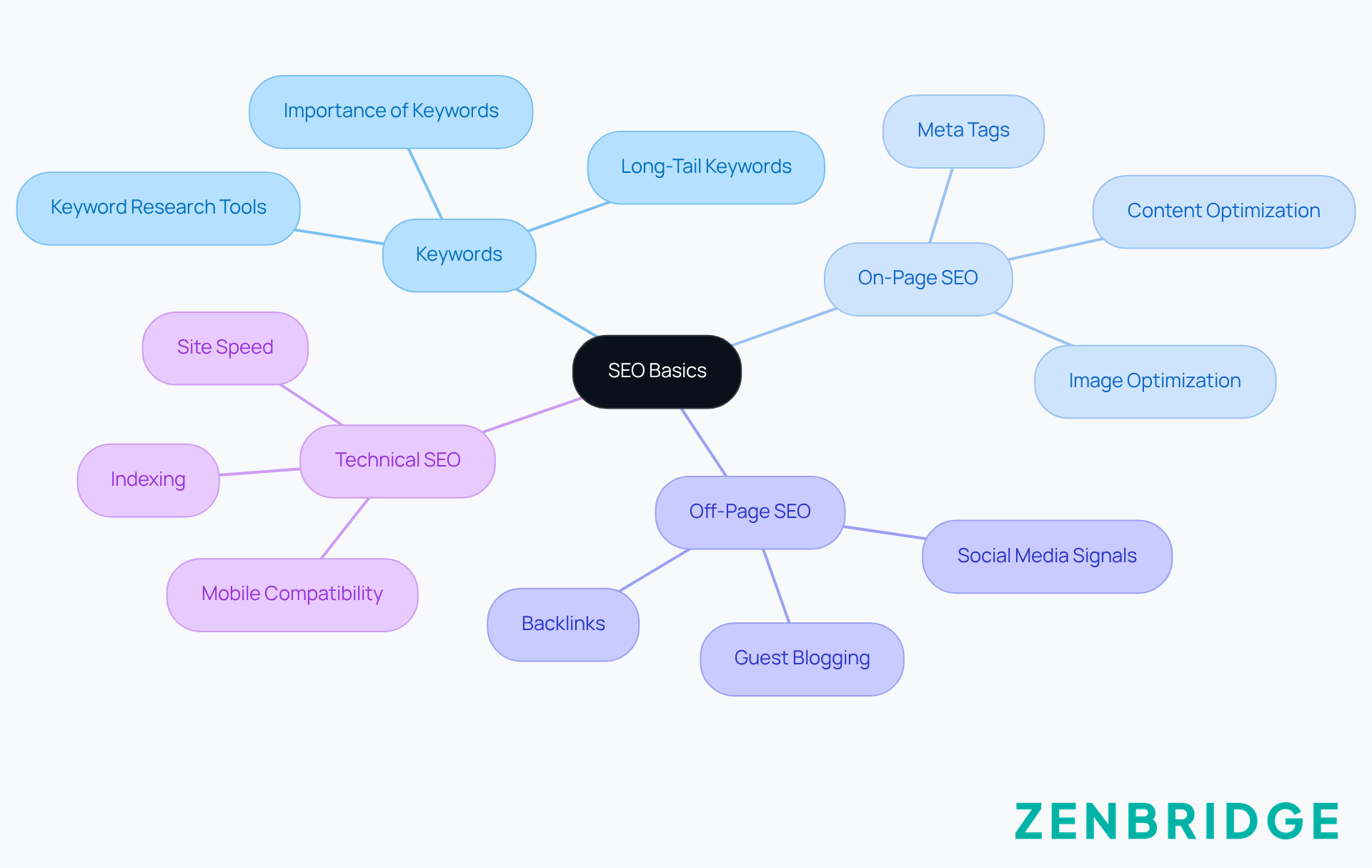
Gather Essential SEO Tools and Resources
Hey there! If you’re looking to perform an SEO website cheque-up, you’ll want to gather some essential tools. Let’s dive in!
-
Google Search Console: This indispensable free tool lets you keep an eye on how your site’s doing in Google search results. It helps you understand indexing issues, search traffic, and overall visibility—super important for effective SEO monitoring. Just a heads up: GSC’s historical data is limited to 16 months, so keep that in mind when you’re analysing trends.
-
SEMrush: A robust SEO platform that packs a punch with features like keyword research, audits, and competitor analysis. Many small businesses have seen great success using it to optimise their online presence. Plus, integrating SEMrush with GSC can really boost your overall SEO strategy.
-
Ahrefs: Known for its fantastic backlink analysis, Ahrefs also shines in keyword tracking and audits. It’s a valuable tool for getting a grip on your online authority and performance.
-
Screaming Frog: This crawler is a must-have for spotting technical SEO issues like broken links and duplicate content. It helps ensure your site runs smoothly. When you use Screaming Frog alongside GSC, you get a comprehensive look at your web presence’s health.
-
Yoast SEO: If you’re on WordPress, this plugin is your best friend for on-page SEO optimisation. It helps boost your content's visibility and relevance.
By using these tools, you’ll gather all the data you need for a thorough SEO website cheque-up. This way, you can pinpoint areas for improvement and really drive your website’s performance forward. Oh, and don’t forget about the URL Inspection tool in Search Console—it can help you request quicker indexing of new pages, which can seriously enhance your visibility. As industry leaders often say, effectively integrating these tools can lead to better insights and results in your SEO efforts. So, what do you think? Ready to get started?
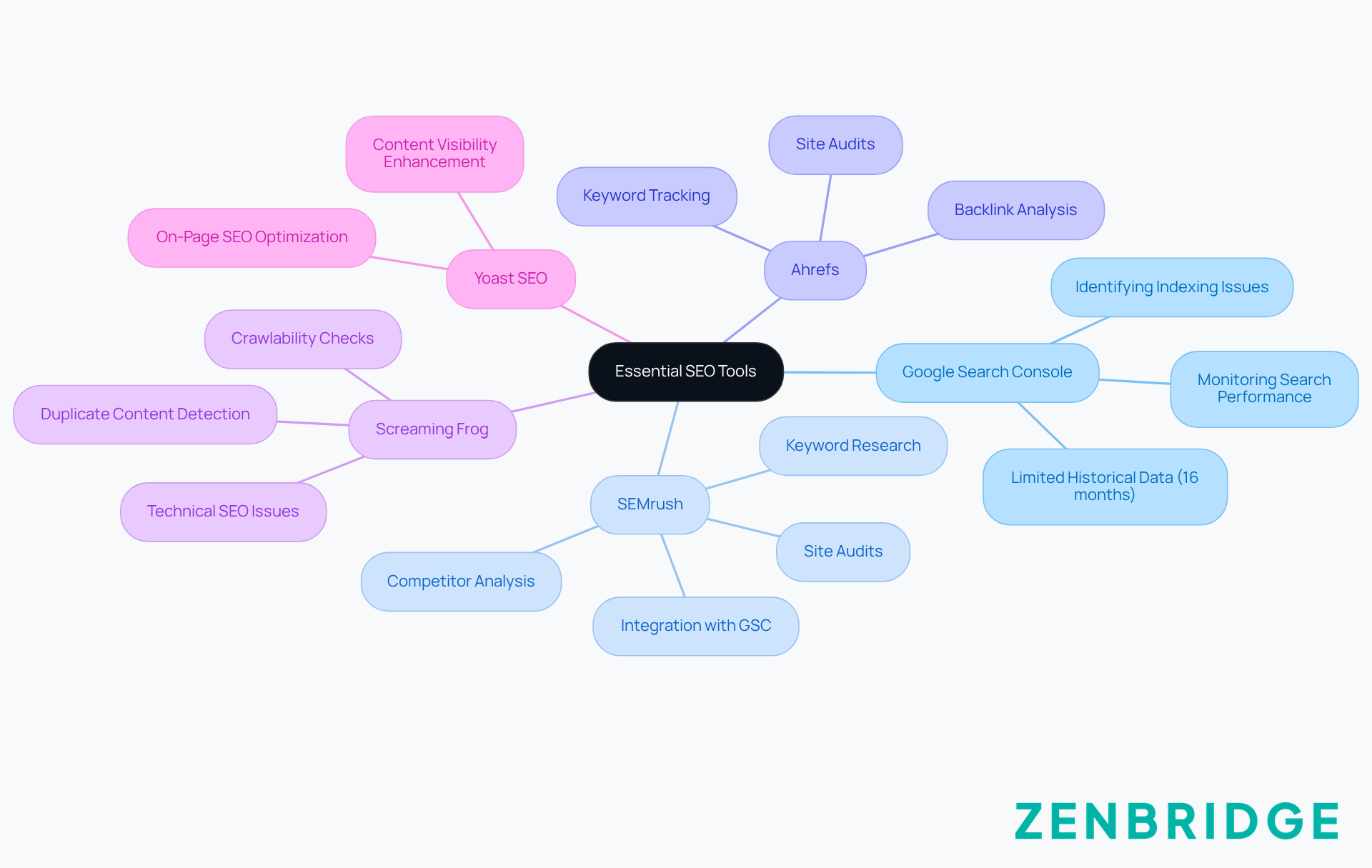
Perform a Comprehensive SEO Audit
Ready to dive into a comprehensive SEO audit? Here’s how you can get started:
- Cheque Website Indexing: First things first, let’s use Search Console to make sure your webpage is indexed correctly. Keep an eye out for any indexing errors that might be keeping your pages from showing up in search results.
- Analyse Website Speed: Next up, grab tools like PageSpeed Insights to cheque how fast your webpage loads. Ideally, you want it to be under three seconds—nobody likes waiting around!
- Review On-Page SEO: Now, take a look at each page for the right use of title tags, meta descriptions, headers, and keyword placement. Make sure the content is relevant and engaging—this is your chance to shine!
- Evaluate Mobile-Friendliness: Have you checked if your site is mobile-friendly? Use Google's Mobile-Friendly Test to ensure your platform is optimised for mobile devices, since this can really impact your rankings.
- Identify Technical Issues: Finally, let’s run Screaming Frog to crawl your webpage and spot any issues like broken links, duplicate content, or missing alt tags.
By following these steps, you’ll have a solid foundation for performing an SEO website cheque up to evaluate your webpage's health. Got questions? Feel free to ask!
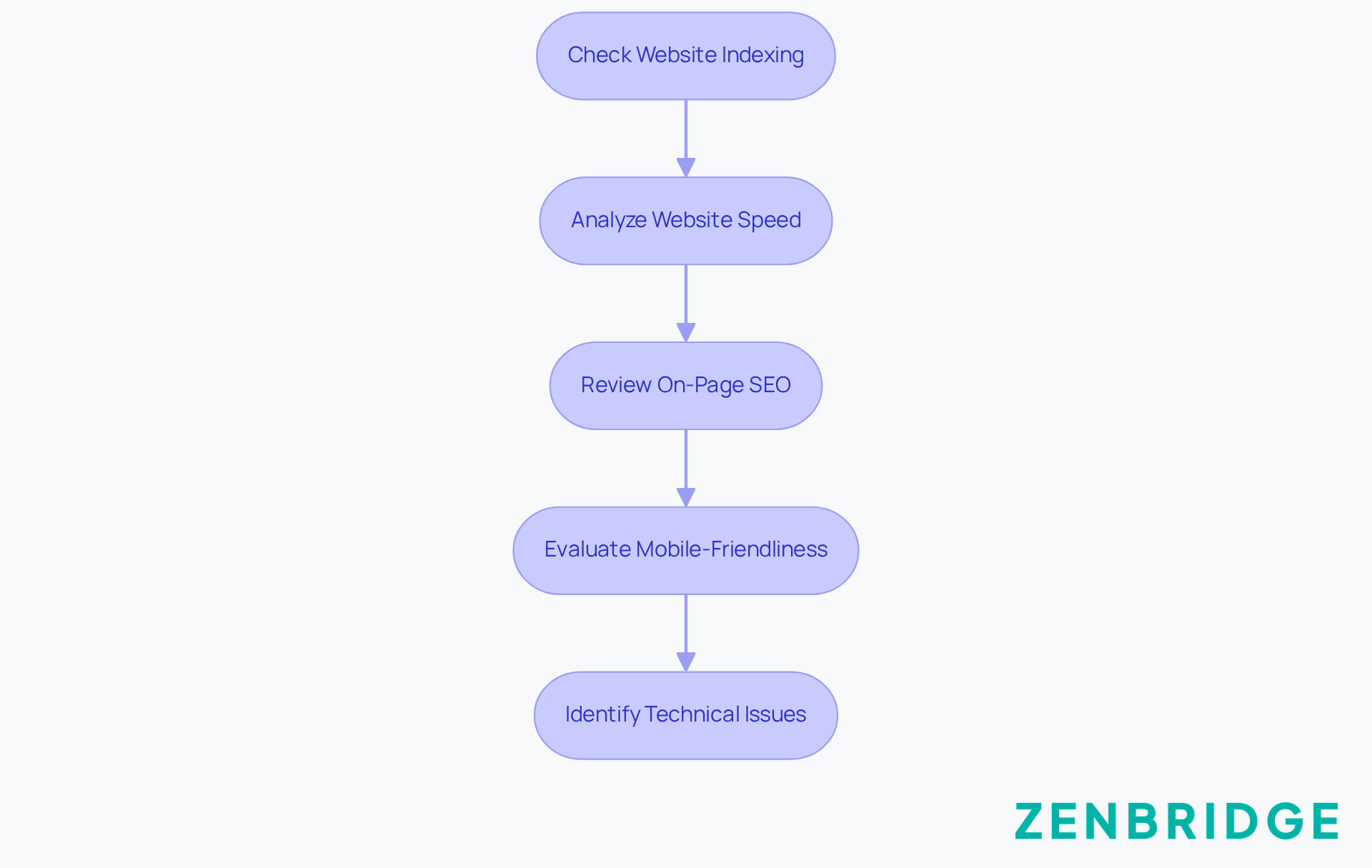
Analyze Audit Results and Identify Improvements
Once you've wrapped up your SEO audit, it’s time to dive into the results and pinpoint areas that need a little TLC:
- Prioritise Issues: Start by categorising the issues based on how much they impact your SEO performance. Focus on the big-ticket items first, like site speed and mobile optimization.
- Set Goals: Next, let’s define some clear, measurable goals for each area you want to improve. For instance, how about aiming to cut down your page load time by 20% or boost your organic traffic by 30% in the next six months?
- Create an Action Plan: Now, develop a step-by-step action plan to tackle each issue. Assign tasks and set deadlines to keep everyone accountable.
- Monitor Competitors: Don’t forget to keep an eye on your competitors! Analysing their SEO strategies can help you spot gaps in your own approach. Tools like SEMrush are great for figuring out what keywords and tactics they’re successfully using.
This analysis will guide your next steps in making those changes to enhance your site's performance after conducting an seo website cheque up. You ready to get started?
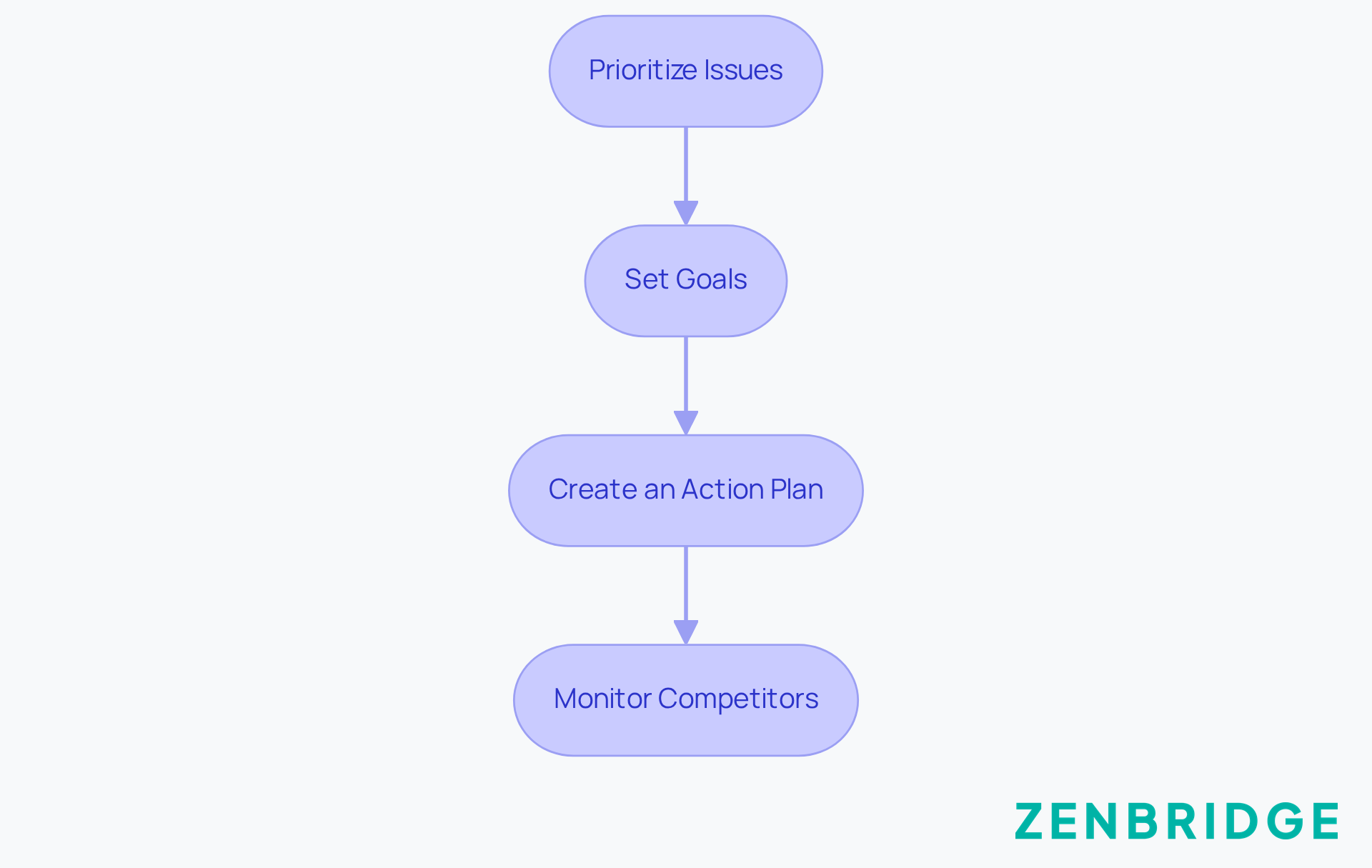
Implement Changes and Monitor Progress
To make changes and keep an eye on your progress, here’s what you can do:
- Make Necessary Changes: Start by tackling those high-priority issues you found in your audit. This could mean speeding up your page load times, refreshing your content, or fixing any technical hiccups.
- Use Monitoring Tools: Get tools like Google Analytics and Google Search Console set up. They’ll help you track changes in traffic, rankings, and how users are behaving. Make it a habit to check these metrics regularly to see how your changes are doing.
- Adjust Strategies as Needed: Based on the data you gather, be ready to tweak your strategies. If some changes aren’t giving you the results you hoped for, dig deeper and refine your approach.
- Schedule Regular Audits: Plan to do SEO audits at regular intervals—like every quarter—to keep your site optimised and spot new areas for improvement.
- Stay Updated on SEO Trends: SEO is always changing, so stay in the loop with the latest trends and algorithm updates to keep your strategies sharp.
By following these steps, you can keep your website performing well in search engine rankings and on track to meet your business goals. You got this!
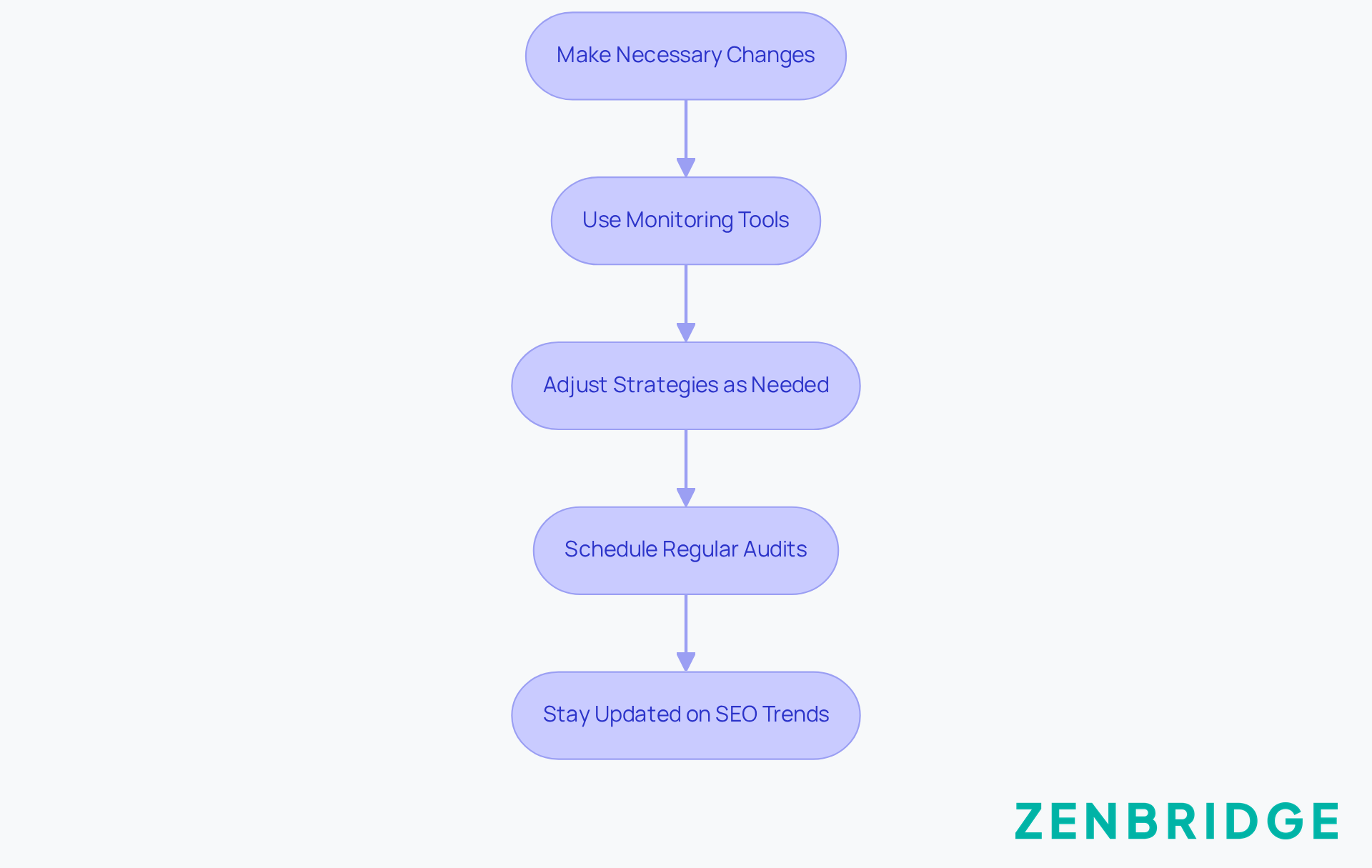
Conclusion
Making sure your website is optimised for search engines is super important for boosting visibility and driving traffic. So, let’s break down a simple approach to give your site an effective SEO cheque-up. It’s all about getting to know the basics of SEO, using the right tools, conducting thorough audits, analysing what you find, and making the necessary tweaks. By following these steps, you can really amp up your online presence and keep users engaged.
Now, here’s the deal: you want to focus on those high-impact issues first, set some measurable goals, and keep an eye on your progress with tools like Google Analytics and SEMrush. Each step in the SEO cheque-up builds on the last, creating a solid foundation for ongoing optimisation. This proactive strategy not only tackles current issues but also gets your website ready to adapt to the ever-changing SEO landscape and algorithm updates.
In the end, you can’t underestimate the importance of a thorough SEO website cheque-up. It empowers you to refine your online strategies and stay competitive in a digital world that’s always evolving. Taking action today can lead to better search rankings, more traffic, and greater overall success. So, why not embrace these steps and tools to turn your website into a powerful asset for your business?
Frequently Asked Questions
What is Search Engine Optimisation (SEO)?
SEO is the process of improving your online platform's visibility on search engines like Google by optimising various components such as keywords, on-page elements, off-page factors, and technical aspects.
What are the key components of SEO?
The key components of SEO include:
- Keywords: Terms users type into search engines that are crucial for reaching your audience.
- On-Page SEO: Optimising individual pages on your site, including content, meta tags, and images.
- Off-Page SEO: Factors outside your website, such as backlinks that enhance domain authority and ranking.
- Technical SEO: Focuses on technical elements like site speed, mobile compatibility, and indexing.
How does ZenBridge's UpRank service help with SEO?
ZenBridge's UpRank service guarantees clients +15 new 5-star reviews and at least one keyword in the Top-3 within 90 days, or they will continue working for free until those results are achieved. Clients typically see visibility and call volume increases within 30 days, with significant growth usually occurring around 60-90 days.
What tools are essential for conducting an SEO website cheque-up?
Essential tools for an SEO website cheque-up include:
- Google Search Console: Monitors site performance in Google search results, including indexing issues and search traffic.
- SEMrush: Offers keyword research, audits, and competitor analysis to optimise online presence.
- Ahrefs: Known for backlink analysis, keyword tracking, and audits to assess online authority.
- Screaming Frog: A crawler that identifies technical SEO issues like broken links and duplicate content.
- Yoast SEO: A WordPress plugin that assists with on-page SEO optimisation.
How can Google Search Console assist in SEO efforts?
Google Search Console helps monitor your site's performance in search results, identifies indexing issues, tracks search traffic, and provides insights into overall visibility, which is essential for effective SEO monitoring.
What is the benefit of integrating SEMrush with Google Search Console?
Integrating SEMrush with Google Search Console enhances your overall SEO strategy by combining their features for better keyword research, audits, and competitor analysis.
How does Screaming Frog contribute to SEO?
Screaming Frog helps identify technical SEO issues such as broken links and duplicate content, ensuring your site runs smoothly and effectively.
What is the URL Inspection tool in Google Search Console?
The URL Inspection tool allows you to request quicker indexing of new pages, which can significantly enhance your site's visibility in search results.

